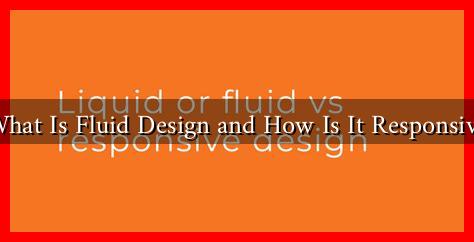-
Table of Contents
What Is Fluid Design and How Is It Responsive?
In the ever-evolving landscape of web design, the terms “fluid design” and “responsive design” often surface in discussions about creating user-friendly interfaces. While both concepts aim to enhance user experience across various devices, they do so in distinct ways. This article delves into the intricacies of fluid design, its principles, and how it relates to responsive design.
Understanding Fluid Design
Fluid design, also known as liquid design, refers to a web design approach that allows elements on a webpage to resize and adapt fluidly to the size of the browser window. Unlike fixed-width designs, which maintain a set width regardless of the screen size, fluid designs use relative units like percentages instead of absolute units like pixels. This adaptability ensures that content remains accessible and visually appealing on any device.
Key Principles of Fluid Design
Fluid design is built on several core principles that guide its implementation:
- Proportional Layouts: Elements are sized in relation to their parent containers, allowing for a seamless transition between different screen sizes.
- Flexible Images: Images and media are set to scale within their containers, ensuring they do not overflow or become distorted.
- Viewport Units: Utilizing viewport width (vw) and height (vh) units allows designers to create layouts that respond dynamically to the user’s screen size.
- CSS Media Queries: While fluid design focuses on relative sizing, media queries can still be employed to adjust styles at specific breakpoints for enhanced control.
Fluid Design vs. Responsive Design
While fluid design and responsive design share the goal of creating adaptable web experiences, they differ in their approaches:
- Fluid Design: Focuses on continuous resizing of elements based on the browser window size, creating a smooth transition without distinct breakpoints.
- Responsive Design: Utilizes fixed breakpoints to adjust layouts and styles at specific screen sizes, allowing for more control over how content is displayed on different devices.
In practice, many modern websites incorporate both fluid and responsive design principles to achieve optimal user experiences. For instance, a website may use fluid grids for its layout while employing responsive techniques for navigation menus and images.
Real-World Examples of Fluid Design
Several well-known websites exemplify fluid design principles:
- Bootstrap: This popular front-end framework utilizes a fluid grid system that allows developers to create responsive layouts effortlessly.
- CSS Tricks: The website employs fluid design to ensure that its content is easily readable on devices ranging from smartphones to large desktop monitors.
- Smashing Magazine: Known for its articles on web design, Smashing Magazine uses fluid design to maintain readability and accessibility across various screen sizes.
Statistics Supporting Fluid Design
The importance of fluid design is underscored by various statistics:
- According to Statista, mobile devices accounted for over 54% of global website traffic in 2021, highlighting the need for adaptable designs.
- A study by Google found that 53% of mobile users abandon sites that take longer than three seconds to load, emphasizing the importance of efficient design.
- Websites that employ responsive design can see a 20% increase in conversion rates, as users are more likely to engage with content that is easy to navigate.
Conclusion
Fluid design is a crucial aspect of modern web development, allowing for seamless user experiences across a multitude of devices. By focusing on proportional layouts, flexible images, and the use of viewport units, designers can create websites that adapt gracefully to any screen size. While fluid design and responsive design are distinct approaches, they often work best in tandem to deliver optimal user experiences. As mobile traffic continues to rise, embracing fluid design principles will be essential for businesses looking to engage their audiences effectively.
For further reading on fluid and responsive design, consider exploring resources like Smashing Magazine and CSS Tricks.


